Quick Facts: Energy
|
1. The history of civilization is also the history of the human use of energy. Both progressed from human muscle power to wood for fire in pre-historic times; to animal muscle power made possible by agricultural surpluses; to water, wind and steam in the pre-industrial era; and to coal, oil, gas and electricity in the industrial period. Up to the fossil fuel era, human energy use involved exploiting natural energy flows, in photosynthesis, water flows and food chains.
2. Prior to the Industrial Revolution, at least 70% of all work was done by human muscle power; most of the rest was done by domesticated animals.
3. More energy was used by humans in the 20th century than in all of previous human history. This was largely due to the development of various technologies that allowed for the widespread exploitation of fossil fuels –coal, oil and natural gas.
   |
|
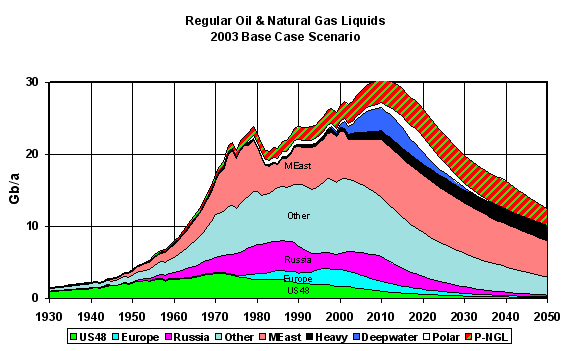 4. Fossil fuels represent a unique energy resource – one which was created by natural processes over hundreds of millions of years; which are highly concentrated; and easily transportable. Human use will deplete these unique resources significantly over a short time span of approximately three centuries (1850 to 2150). 4. Fossil fuels represent a unique energy resource – one which was created by natural processes over hundreds of millions of years; which are highly concentrated; and easily transportable. Human use will deplete these unique resources significantly over a short time span of approximately three centuries (1850 to 2150).
| |
|
|
5. On a global scale, the main energy sources are approximately: oil 35%; coal 23 %; natural gas 21%; biomass and waste 10%; nuclear 6%; hydro 2%; with wind, solar, and geothermal together making up only 2%. Of these sources, over 80% are non-renewable and in decline. By the end of this century it is unlikely these sources will be able to provide even 20% of global energy needs. |
|
|
|
 6. Peak oil production refers to the year in which global oil production will reach its peak, and then begin to decline. This will likely occur when about half the world''s oil is used, after which its increasing scarcity will lead to dramatically increased prices for oil. Global peak oil production is thought most likely to occur sometime in the next decade, although it should be noted that forecasts of energy use are notoriously unreliable. 6. Peak oil production refers to the year in which global oil production will reach its peak, and then begin to decline. This will likely occur when about half the world''s oil is used, after which its increasing scarcity will lead to dramatically increased prices for oil. Global peak oil production is thought most likely to occur sometime in the next decade, although it should be noted that forecasts of energy use are notoriously unreliable.
| |
|
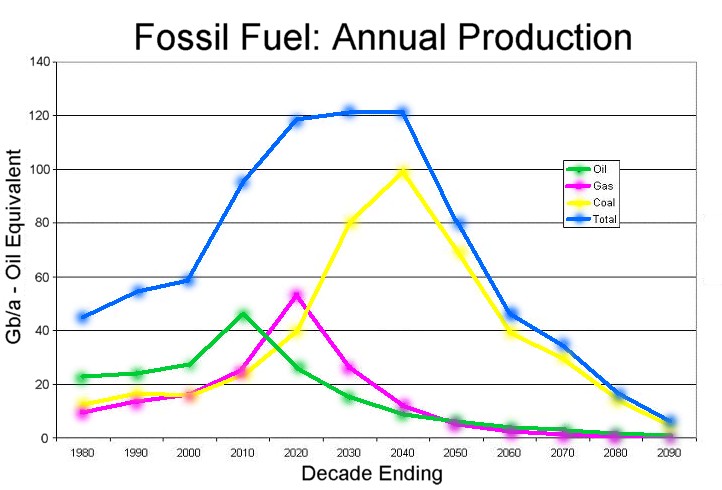 7. All of the non-renewable energy sources upon which our civilization currently relies, may reach their peak production capacity sometime in the present century, with the possible exception of coal. It is questionable whether renewable technologies will be capable of completely making up for the decline in fossil fuels, let alone provide additional growth.
7. All of the non-renewable energy sources upon which our civilization currently relies, may reach their peak production capacity sometime in the present century, with the possible exception of coal. It is questionable whether renewable technologies will be capable of completely making up for the decline in fossil fuels, let alone provide additional growth.
|
|
|
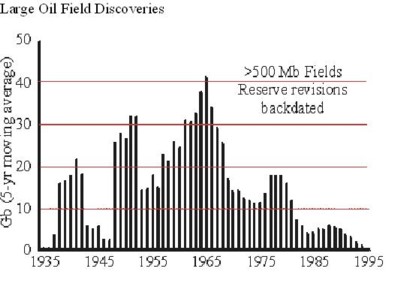 8. The number of new mega oil projects (those with reserves of at least 500 million barrels, and capable of producing at least 100,000 barrels a day) expected to come onstream over the next few years is declining: 8. The number of new mega oil projects (those with reserves of at least 500 million barrels, and capable of producing at least 100,000 barrels a day) expected to come onstream over the next few years is declining:
| |
|
- In 2005 18 mega projects expected
- In 2006 11 expected
- In 2007 3 expected
- In 2008 3 expected
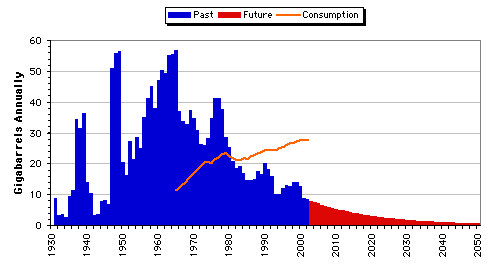 9. Future oil production capacity is not expected to meet the increase in demand. Most new projects are from technically more difficult and therefore more costly (in both energy and financial terms) “unconventional” sources (tar sands, offshore in deep oceans, oil shale, in arctic areas). 9. Future oil production capacity is not expected to meet the increase in demand. Most new projects are from technically more difficult and therefore more costly (in both energy and financial terms) “unconventional” sources (tar sands, offshore in deep oceans, oil shale, in arctic areas).
| |
|
 10. Since the “oil crisis” of the late 1970’s extensive exploration of potential oil fields has occurred, much of it using sophisticated new technologies. These meager results are confirmation that there are unlikely to be more than a very few large fields left to discover.
10. Since the “oil crisis” of the late 1970’s extensive exploration of potential oil fields has occurred, much of it using sophisticated new technologies. These meager results are confirmation that there are unlikely to be more than a very few large fields left to discover.
|
|
|
|
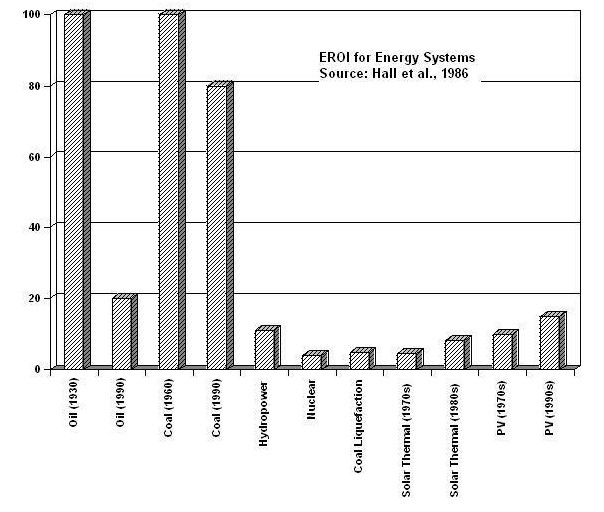
11. It takes energy to make energy. For every unit of energy used to find, extract, refine and deliver energy to end users, fewer and fewer units of energy will be produced. This energy return on investment (or EROI) is declining as we move from conventional to nonconventional sources of oil and gas, and will decline even further as we move to renewables. | |
|
|
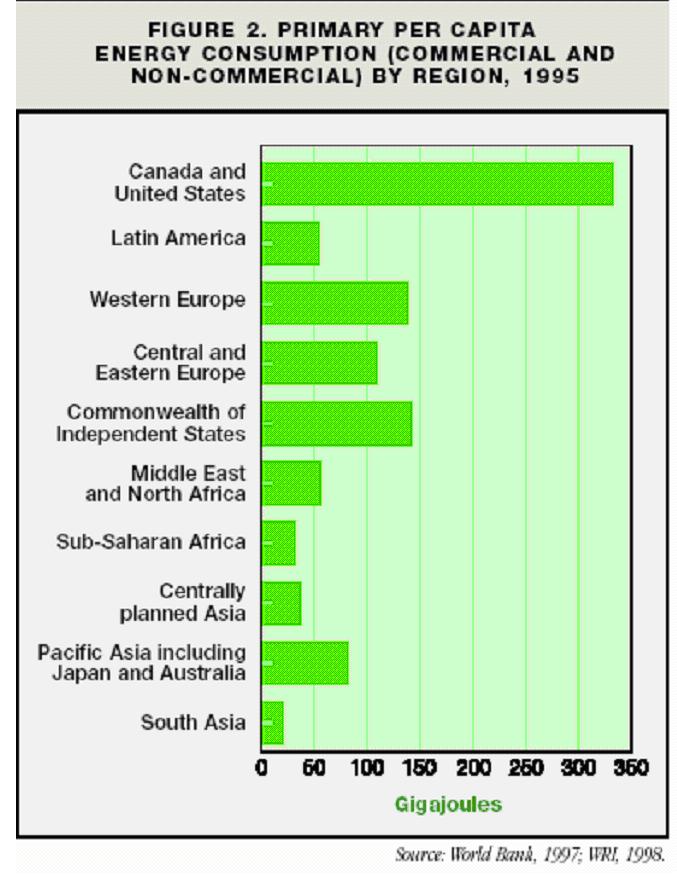 12. Global demand for energy is expected to rise over the coming decades by 1.5% per year. At this rate global energy demands would double between 2000 and 2035, and treble by 2055. The greater the increase in demand, the sooner peak production for all non-renewable energy sources will occur. Declining demand for non-renewable energy sources would prolong their availability. 12. Global demand for energy is expected to rise over the coming decades by 1.5% per year. At this rate global energy demands would double between 2000 and 2035, and treble by 2055. The greater the increase in demand, the sooner peak production for all non-renewable energy sources will occur. Declining demand for non-renewable energy sources would prolong their availability.
|
|
|
13. Use of energy in the 20th century has been concentrated in a few nations, representing a small portion of the earth’s population. The seven largest economies at the end of the 20th century (with 10% of the global population) used about 45% of the total primary energy supply. Approximately 2 billion people worldwide do not have access to electricity. | |
|
|
 14. Per capita energy consumption is approximately 1300% higher in North America than in Southeast Asia. The average North American’s annual energy consumption is equivalent to having 75 human slaves. 14. Per capita energy consumption is approximately 1300% higher in North America than in Southeast Asia. The average North American’s annual energy consumption is equivalent to having 75 human slaves.
| |
|
|
 15. Energy for transportation is the biggest user of petroleum, and the sector where demand is increasing most rapidly. Air transportation is particularly dependent on oil and therefore particularly vulnerable. Whenever the anticipated oil peak occurs, it will have an especially dramatic impact on this and related sectors. 15. Energy for transportation is the biggest user of petroleum, and the sector where demand is increasing most rapidly. Air transportation is particularly dependent on oil and therefore particularly vulnerable. Whenever the anticipated oil peak occurs, it will have an especially dramatic impact on this and related sectors.
| |
|
16. A variety of technical and financial challenges will need to be overcome if renewable energy resources are to provide anything like the anticipated demands based on current patterns of consumption: | |
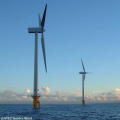 10,000 more of the largest nuclear reactors would be needed to replace current levels of fossil fuel use (safety and disposal concerns may eliminate this option altogether) 10,000 more of the largest nuclear reactors would be needed to replace current levels of fossil fuel use (safety and disposal concerns may eliminate this option altogether)
- use of all remaining coal and other fossil fuels will likely trigger severe climate change
- direct solar is limited by the rate of energy emitted by the sun, its low concentration on earth, and its relatively low energy return on investment
- wind is limited in terms of location
- use of biomass will be competing for agricultural land with growing global food requirements
- hydrogen is not a fuel but a carrier, and itself requires energy to produce. Clean and safe production will be a significant challenge.
- hydro, wave/tidal and geothermal are too limited geographically.
|
|
|
| 17. Conservation and increased energy efficiencies offer important opportunities for meeting global energy needs. Currently, energy efficiency on a global scale (the amount of energy actually used to do work as a portion of the amount consumed) is approximately 37%. A variety of technical and social strategies will be required to reduce overall energy demand. |
|
|
18. A successful transition from non-renewable to renewable fuel sources by the end of this century may require a dramatic reduction in global energy use. However, it may be possible to maintain a desirable quality of life for the world''s population with the per capita supply then available, provided we learn to reduce our expectations. |